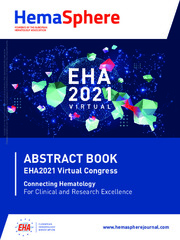Prikaz osnovnih podataka o dokumentu
Influence of inflammatory cytokines on S100A proteins expression in CLL patients
| dc.creator | Mitrović-Ajtić, Olivera | |
| dc.creator | Diklić, Miloš | |
| dc.creator | Antić, Darko | |
| dc.creator | Mihaljević, Biljana | |
| dc.creator | Vuković, Vojin | |
| dc.creator | Otašević, Vladimir | |
| dc.creator | Tomić, Kristina | |
| dc.creator | Čokić, Vladan | |
| dc.date.accessioned | 2024-01-29T20:58:23Z | |
| dc.date.available | 2024-01-29T20:58:23Z | |
| dc.date.issued | 2021 | |
| dc.identifier.issn | 2572-9241 | |
| dc.identifier.uri | http://rimi.imi.bg.ac.rs/handle/123456789/1429 | |
| dc.description.abstract | Background: S100A proteins possess a broad range of intra- and extracellular functions. The involvement of these proteins in inflammation-mediated responses is of particular interests, considering that inflammation represents one of the landmarks of malignancy. Processes such as inflammation and cellular stress trigger the release of S100A proteins to extracellular space, interacting with their receptors and activating numerous intracellular signaling pathways, for instance NF-κB and AP1. Through them, S100A proteins take part into regulation of some of the most essential cellular processes: cell differentiation, apoptosis, inflammation, proliferation, etc. Aims: The aim of the study is to assess the role of inflammation in activation of S100A proteins via proliferation and inflammation related signaling pathways. Methods: We observed 60 CLL patients’ samples to isolate mononuclear cells (MNC) and CD19+ cells. MNC of CLL patients were treated with pro-inflammatory IL-6 and anti-inflammatory IL-10 cytokines, and inhibitors of JAK1/2, NF-κB and PI3K signaling pathways, to evaluate S100A4, S100A8, S100A9, S100A12 and NF-κB protein expression by immunoblotting. Also, we used immunocytochemistry to analyse the number of the S100As immunopositive MNC of CLL patients.Results: S100A8 showed higher level of protein expression in MNC and CD19+cells in comparison to healthy control. The number of immunopositive S100A4 (p<0.05) and S100A9 cells (p<0.001) was signifi cantly decreased in CD19+cells and MNC, respectively of CLL patients in comparison to healthy control. In addition, S100A4 and S100A9 proteins expression had statistically significant lower level of expression in MNC. Also, IL-6 stimulated expression of S100A8 and S100A4 in MNC of CLL, while the expression of latter one was prevented by NF-κB and JAK1/2 inhibitors. IL-10 reduced expression of S100A8 and S100A12 in MNC of CLL.Summary/Conclusion: Pro-inflammatory IL-6 and anti-inflammatory IL-10 cytokines have opposite effect on inflammatory S100A8 protein in CLL, with a potential to be a prognostic marker. | sr |
| dc.language.iso | en | sr |
| dc.publisher | Wolters Kluwer Health, Inc. | sr |
| dc.rights | openAccess | sr |
| dc.rights.uri | https://creativecommons.org/licenses/by-nc-nd/4.0/ | |
| dc.source | HemaSphere - The Abstract Book of the 26th Congress of the European Hematology Association, EHA2021 Virtual Congress | sr |
| dc.title | Influence of inflammatory cytokines on S100A proteins expression in CLL patients | sr |
| dc.type | conferenceObject | sr |
| dc.rights.license | BY-NC-ND | sr |
| dc.citation.epage | 280 | |
| dc.citation.issue | S2 | |
| dc.citation.spage | 280 | |
| dc.citation.volume | 5 | |
| dc.identifier.doi | 10.1097/HS9.0000000000000566 | |
| dc.identifier.fulltext | http://rimi.imi.bg.ac.rs/bitstream/id/3342/Influence_of_inflammatory_cytokines_on_S100A_proteins_expression_in_CLL_patients_conf_2021.pdf | |
| dc.type.version | publishedVersion | sr |

